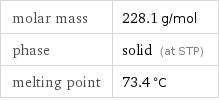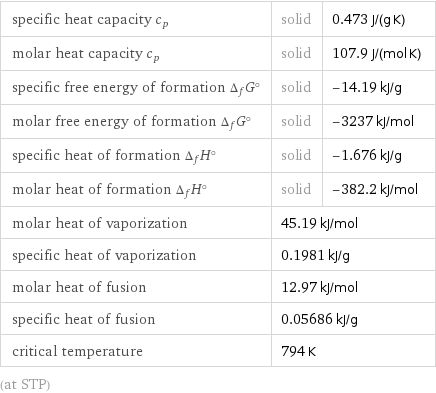Input interpretation

antimony(III) chloride
Chemical names and formulas

formula | SbCl_3 Hill formula | Cl_3Sb name | antimony(III) chloride IUPAC name | trichlorostibane alternate names | antimony trichloride | trichlorostibane mass fractions | Cl (chlorine) 46.6% | Sb (antimony) 53.4%
Lewis structure

Draw the Lewis structure of antimony(III) chloride. Start by drawing the overall structure of the molecule: Count the total valence electrons of the chlorine (n_Cl, val = 7) and antimony (n_Sb, val = 5) atoms: 3 n_Cl, val + n_Sb, val = 26 Calculate the number of electrons needed to completely fill the valence shells for chlorine (n_Cl, full = 8) and antimony (n_Sb, full = 8): 3 n_Cl, full + n_Sb, full = 32 Subtracting these two numbers shows that 32 - 26 = 6 bonding electrons are needed. Each bond has two electrons, so the above diagram has all the necessary bonds. There are 3 bonds and hence 6 bonding electrons in the diagram. Lastly, fill in the remaining unbonded electrons on each atom. In total, there remain 26 - 6 = 20 electrons left to draw: Answer: | |
Basic properties

molar mass | 228.1 g/mol phase | solid (at STP) melting point | 73.4 °C
Units

Solid properties (at STP)

vapor pressure | 0.9998 mmHg
Units

Thermodynamic properties

specific heat capacity c_p | solid | 0.473 J/(g K) molar heat capacity c_p | solid | 107.9 J/(mol K) specific free energy of formation Δ_fG° | solid | -14.19 kJ/g molar free energy of formation Δ_fG° | solid | -3237 kJ/mol specific heat of formation Δ_fH° | solid | -1.676 kJ/g molar heat of formation Δ_fH° | solid | -382.2 kJ/mol molar heat of vaporization | 45.19 kJ/mol | specific heat of vaporization | 0.1981 kJ/g | molar heat of fusion | 12.97 kJ/mol | specific heat of fusion | 0.05686 kJ/g | critical temperature | 794 K | (at STP)
Chemical identifiers
Cl InChI identifier | InChI=1/3ClH.Sb/h3*1H;/q;;;+3/p-3/f3Cl.Sb/h3*1h;/q3*-1;m RTECS number | CC4900000 MDL number | MFCD00011212](../image_source/5a7ee97bbf913a3b0abd1d0e5b610c41.png)
CAS number | 10025-91-9 PubChem CID number | 24814 SMILES identifier | Cl[Sb](Cl)Cl InChI identifier | InChI=1/3ClH.Sb/h3*1H;/q;;;+3/p-3/f3Cl.Sb/h3*1h;/q3*-1;m RTECS number | CC4900000 MDL number | MFCD00011212
Toxicity properties

lethal dosage | 525 mg/kg (oral dose for rats)

probable lethal dose for man | 600 mL (milliliters)